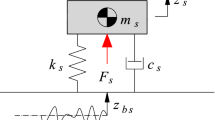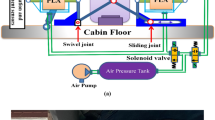Abstract
To enhance the vibratory roller's ride quality, semi-active suspension of the driver's seat embedded by the quasi-zero-stiffness-structure (QZSS) has been proposed and researched. A dynamic model of the vibratory roller is established to evaluate the ride quality of the vehicle and the efficiency of the QZSS added into the semi-active seat suspension under the various operating conditions of the vibratory roller. The experiment with the vibratory roller is also given to verify the accuracy of the mathematical model. Two indexes of the root mean square seat acceleration in the time domain (aws) and power spectral density (PSD) seat acceleration in the frequency domain are chosen as the objective functions. The study indicates that the vehicle's ride quality with the semi-active seat suspension is better than that of the passive seat suspension, while the vehicle's ride quality with the semi-active seat suspension embedded by the QZSS is remarkably improved in compared to the semi-active seat suspension without the QZSS. Especially, the aws and maximum PSD of the driver's seat are greatly decreased by 76.0% and 73.4% in comparison with the passive seat suspension, respectively. Consequently, the semi-active seat suspension should be embedded by the QZSS to further improve the vibratory roller's ride quality.













Similar content being viewed by others
Data availability
All data generated or analyzed during this study are included in this published article.
Code Availability
The MATLAB code used for the simulation can be provided via email if required.
References
Adam D, Kopf F (2000) Theoretical analysis of dynamically loaded soils. European workshop compaction of soils and granular materials. Paris, France 2000: 207–220
Le V (2013) Vibration study and control for cab of vibratory roller. Southeast University, Nanjing
Zhang J, Yang Z et al (2019) Low–frequency performance of semi-active cab’s hydraulic mounts of an off-road vibratory roller. Shock Vib 2019:1–15. https://doi.org/10.1155/2019/8725382
Hua W, Hua X et al (2021) Experimental investigation and vibration control of semi-active hydraulic–pneumatic mounts for vibratory roller cab. SAE Int J Veh Dyn Stab NVH 5(4):381–392. https://doi.org/10.4271/03-15-03-0019
International Organization for Standardization (1997) ISO 2631–1 Mechanical vibration and shock–evaluation of human exposure to whole body vibration–Part 2: general requirement. Geneva, Switzerland: International Organization for Standardization
Fargione G, Tringali D, Risitano G (2016) A fuzzy-genetic control system in the ABS for the control of semi-active vehicle suspensions. Mechatronics 39:89–102. https://doi.org/10.1016/j.mechatronics.2016.08.004
Robert J, Kumar P, Nair S, Moni D, Swarneswar B (2022) Fuzzy control of active suspension system based on quarter car model. Mater Today Proc 66:902–908. https://doi.org/10.1016/j.matpr.2022.04.575
Nguyen V, Jiao R, Zhang J (2020) Control performance of damping and air spring of heavy truck air suspension system with optimal fuzzy control. SAE Int J Veh Dyn Stab NVH 4(2):179–194. https://doi.org/10.4271/10-04-02-0013
Homaeinezhad MR, Gavari MA (2022) Feedback control of actuation-constrained moving structure carrying Timoshenko beam. Int J Robust Nonlinear Control. https://doi.org/10.1002/rnc.6471
Ebrahimi N, Gharaveisi A (2012) Optimal fuzzy supervisor controller for an active suspension system. Int J Soft Com Eng 2(4):36–39
Li S, Jiao R, Ni D, Zhou H et al (2022) Isolation efficiency of vehicle seat suspension with three quasi-zero stiffness models. Int J Acoust Vib 27(3):210–220. https://doi.org/10.20855/ijav.2022.27.31858
Ni D et al (2022) Performance analysis of the seat suspension using different models of the optimal negative-stiffness-structures. Proc IMechE Part D J Automob Eng 237:1–12. https://doi.org/10.1177/09544070221091040
Zha J, Ni D, Su B et al (2022) Optimizing the geometrical dimensions of the seat suspension equipped with a negative stiffness structure based on a genetic algorithm. SAE Int J Veh Dyna Stab NVH 6:11–20. https://doi.org/10.4271/10-06-02-0010
Chang Y, Zhou J, Wang K, Xu D (2022) Theoretical and experimental investigations on semi-active quasi-zero-stiffness dynamic vibration absorber. Int J Mech Sci 214(15):106892. https://doi.org/10.1016/j.ijmecsci.2021.106892
Zhang X (2013) Modelling, simulation and optimization of ride comfort for off road articulated dump trucks. Southeast University, Nanjing
Bekker M (1969) Introduction to terrain-vehicle system. University of Michigan Press, Ann Arbor, USA
International Organization for Standardization (1982) ISO/TC108/ SC2/WG4 N57 Reporting vehicle road surface irregularities. Stuttgart, Germany: Thieme Medical, Pulishers
Wong J (2001) Theory of ground vehicles. John Wiley & Sons, New York, NY, USA
Mitschke M (1972) Dynamik der kraftfahrzeuge. Berlin, Springer–Verlag, Berlin. https://doi.org/10.1007/978-3-662-11585-5
Mamdani E, Assilian S (1999) An experiment in linguistic synthesis with a fuzzy logic controller. Int J Human-Comput Stud 51:135–147
Bernadette K, Odon M, Judith W et al (2015) Finite element analysis of vibratory roller response on layered soil systems. Comput Geotech 67:73–82. https://doi.org/10.1016/j.compgeo.2015.02.015
Funding
This work has been supported by the Guidance Project of Science and Technology Research Program of Education Department of Hubei Province, China (No. B2022254).
Author information
Authors and Affiliations
Contributions
All authors contributed to the study conception and design. Material preparation, data collection, models of the vibratory roller, semi-active seat suspension, and QZSS as well as calculation of the dynamic equations were performed by Tianfeng Ye. The first draft of the manuscript was written by Vanliem Nguyen. The simulation and analysis the results were performed by Shiming Li. All authors read and approved the final manuscript.
Corresponding author
Ethics declarations
Conflict of interest
Tianfeng Ye is a lecturer at School of Electrical and Electronic Information Engineering, Hubei Polytechnic University, Huangshi, China. Her current research interests include control system, optimal design, and stability of vibration system. Vanliem Nguyen is a doctor at School of Mechanical and Electrical Engineering, Hubei Polytechnic University, Huangshi, China. His current research interests include vehicle dynamics, vibration and optimization control, and lubrication in the engine. Shiming Li is a lecturer at School a doctor at School of Mechanical and Electrical Engineering, Hubei Polytechnic University, Huangshi, China. His current research interests include vehicle dynamics, vibration and optimization control.
Rights and permissions
Springer Nature or its licensor (e.g. a society or other partner) holds exclusive rights to this article under a publishing agreement with the author(s) or other rightsholder(s); author self-archiving of the accepted manuscript version of this article is solely governed by the terms of such publishing agreement and applicable law.
About this article
Cite this article
Ye, T., Nguyen, V. & Li, S. Enhancing the vibratory roller's ride comfort with semi-active seat suspension embedded by quasi-zero stiffness structure. Int. J. Dynam. Control 11, 2069–2081 (2023). https://doi.org/10.1007/s40435-023-01127-3
Received:
Revised:
Accepted:
Published:
Issue Date:
DOI: https://doi.org/10.1007/s40435-023-01127-3




